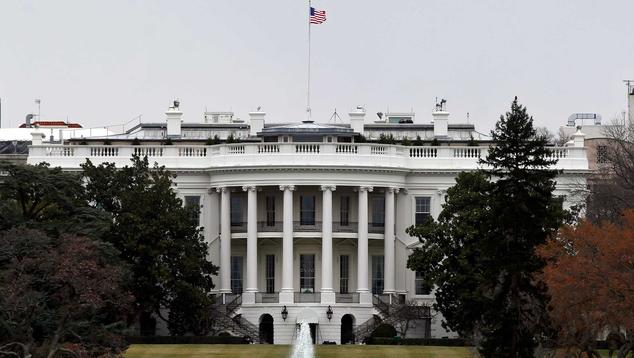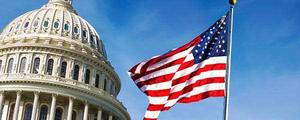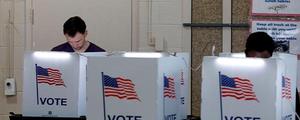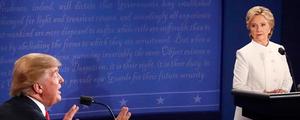Story Highlights
- Ford, Bush saw their approval ratings rise after losing
- Carter's postelection approval ratings declined
WASHINGTON, D.C. -- Unofficial vote counts indicate Donald Trump has become the fourth U.S. incumbent president defeated for reelection in the Gallup polling era. Gallup will release its first postelection approval rating on Trump in the coming days. His final preelection approval rating was 46%, which ranks as the highest for a defeated presidential candidate. According to the latest 2020 election vote totals, he has received 47% of the popular vote and trails Joe Biden by four percentage points, a closer contest than many polls were predicting.
Two of the three incumbents defeated for reelection -- Gerald Ford and George H.W. Bush -- enjoyed increases in their job approval ratings during their "lame duck" periods. The third, Jimmy Carter, had lower approval ratings after being defeated than he had before the election.
Gerald Ford
Ford was the only person to serve as president who was elected to neither the vice presidency nor the presidency. He was appointed as vice president after Spiro Agnew's resignation and ascended to the presidency less than a year later, after Richard Nixon resigned amid the Watergate scandal.
Ford's initially high job approval ratings quickly fell after he pardoned Nixon in September 1974. After that, his approval ratings rarely exceeded 50%. Gallup's last measure of Ford's approval rating before the 1976 presidential election, in which he sought election in his own right and lost a close race to Carter, was 45% in June of that year. Gallup measured Ford's approval rating once more while he was in office -- in December 1976 -- when 53% approved of him, an eight-percentage-point increase from his prior rating.
Ford's approval rating rose among all political groups after he was defeated, but more so among his fellow Republicans.
| U.S. adults | Republicans | Independents | Democrats | |||||||||||||||||||||||||||||||||||||||||||||||||||||||||||||||||||||||||||||||||||||||||||||||||
|---|---|---|---|---|---|---|---|---|---|---|---|---|---|---|---|---|---|---|---|---|---|---|---|---|---|---|---|---|---|---|---|---|---|---|---|---|---|---|---|---|---|---|---|---|---|---|---|---|---|---|---|---|---|---|---|---|---|---|---|---|---|---|---|---|---|---|---|---|---|---|---|---|---|---|---|---|---|---|---|---|---|---|---|---|---|---|---|---|---|---|---|---|---|---|---|---|---|---|---|---|
| % | % | % | % | |||||||||||||||||||||||||||||||||||||||||||||||||||||||||||||||||||||||||||||||||||||||||||||||||
| Preelection | ||||||||||||||||||||||||||||||||||||||||||||||||||||||||||||||||||||||||||||||||||||||||||||||||||||
| 1976 Jun 11-14 | 45 | 68 | 46 | 35 | ||||||||||||||||||||||||||||||||||||||||||||||||||||||||||||||||||||||||||||||||||||||||||||||||
| Postelection | ||||||||||||||||||||||||||||||||||||||||||||||||||||||||||||||||||||||||||||||||||||||||||||||||||||
| 1976 Dec 10-13 | 53 | 80 | 54 | 40 | ||||||||||||||||||||||||||||||||||||||||||||||||||||||||||||||||||||||||||||||||||||||||||||||||
| Change (pct. pts.) | +8 pts. | +12 pts. | +8 pts. | +5 pts. | ||||||||||||||||||||||||||||||||||||||||||||||||||||||||||||||||||||||||||||||||||||||||||||||||
| Gallup | ||||||||||||||||||||||||||||||||||||||||||||||||||||||||||||||||||||||||||||||||||||||||||||||||||||
Jimmy Carter
Like Ford, Carter had high job approval ratings when he took office. However, his presidency was plagued by similar economic challenges to those Ford faced. Carter also struggled to deal with a national energy crisis, and by his third year, his approval rating had fallen below 30%. The seizure of U.S. hostages in Iran and the Soviet invasion of Afghanistan propelled his approval rating back above 50% in late 1979 and early 1980, but those rallies proved short-lived, and his final job approval rating before the 1980 election was 37%.
Gallup's first postelection measure of Carter's job approval rating was 31% in a Nov. 21-24 poll. A subsequent poll in early December -- the last of his presidency -- had Carter at 34% approval.
The post-defeat decline in Carter's approval rating was led by his fellow Democrats, whose approval of him fell 12 points. Republicans' already low approval of Carter held steady, while independents' views held steady in the first postelection poll but rose in the second.
| U.S. adults | Republicans | Independents | Democrats | |||||||||||||||||||||||||||||||||||||||||||||||||||||||||||||||||||||||||||||||||||||||||||||||||
|---|---|---|---|---|---|---|---|---|---|---|---|---|---|---|---|---|---|---|---|---|---|---|---|---|---|---|---|---|---|---|---|---|---|---|---|---|---|---|---|---|---|---|---|---|---|---|---|---|---|---|---|---|---|---|---|---|---|---|---|---|---|---|---|---|---|---|---|---|---|---|---|---|---|---|---|---|---|---|---|---|---|---|---|---|---|---|---|---|---|---|---|---|---|---|---|---|---|---|---|---|
| % | % | % | % | |||||||||||||||||||||||||||||||||||||||||||||||||||||||||||||||||||||||||||||||||||||||||||||||||
| Preelection | ||||||||||||||||||||||||||||||||||||||||||||||||||||||||||||||||||||||||||||||||||||||||||||||||||||
| 1980 Sep 12-15 | 37 | 12 | 22 | 61 | ||||||||||||||||||||||||||||||||||||||||||||||||||||||||||||||||||||||||||||||||||||||||||||||||
| Postelection | ||||||||||||||||||||||||||||||||||||||||||||||||||||||||||||||||||||||||||||||||||||||||||||||||||||
| 1980 Nov 21-24 | 31 | 12 | 23 | 50 | ||||||||||||||||||||||||||||||||||||||||||||||||||||||||||||||||||||||||||||||||||||||||||||||||
| 1980 Dec 5-8 | 34 | 14 | 30 | 49 | ||||||||||||||||||||||||||||||||||||||||||||||||||||||||||||||||||||||||||||||||||||||||||||||||
| Change, Sep-Dec (pct. pts.) | -3 pts. | +2 pts. | +8 pts. | -12 pts. | ||||||||||||||||||||||||||||||||||||||||||||||||||||||||||||||||||||||||||||||||||||||||||||||||
| Gallup | ||||||||||||||||||||||||||||||||||||||||||||||||||||||||||||||||||||||||||||||||||||||||||||||||||||
George H.W. Bush
Bush's job approval ratings during his first three years in office were high, including a then-record 89% in early 1991, after the U.S. victory in the Persian Gulf War. But as the economy entered recession, his approval ratings sank. They bottomed out at 29% after the 1992 Democratic convention that nominated Bill Clinton, who went on to defeat Bush. His approval rating recovered somewhat during the later stages of the campaign, but he finished with a weak 34% approval rating in the final preelection poll.
After Bush lost to Clinton, his approval rating surged to 43%, and it continued to climb during the remainder of his presidency. He eventually finished with 56% approval in January 1993 -- an increase of 22 points from before the election.
To some degree, the increased approval could have reflected sympathy for Bush, but it also could have been a product of rallies in support as he addressed international challenges. Bush deployed U.S. troops to help aid the humanitarian and political situation in Somalia in December 1992, and confronted Iraq for January 1993 violations of the cease-fire deal to end the Persian Gulf War.

Line graph. George H.W. Bush's approval rating was 40% in May of 1992 before falling to 29% in July. It recovered somewhat after that, but stood at 34% before the election. After he was defeated, the first postelection poll measured his approval at 43%. Three subsequent polls during the remainder of his term in office put his approval rating at 49%, 49% and 56%.
Compared with his final preelection reading, Bush's first postelection approval rating was up by at least six points among all party groups. By the end of his presidency, all party groups had approval ratings of Bush that were roughly 20 points higher than before the election.
| U.S. adults | Republicans | Independents | Democrats | |||||||||||||||||||||||||||||||||||||||||||||||||||||||||||||||||||||||||||||||||||||||||||||||||
|---|---|---|---|---|---|---|---|---|---|---|---|---|---|---|---|---|---|---|---|---|---|---|---|---|---|---|---|---|---|---|---|---|---|---|---|---|---|---|---|---|---|---|---|---|---|---|---|---|---|---|---|---|---|---|---|---|---|---|---|---|---|---|---|---|---|---|---|---|---|---|---|---|---|---|---|---|---|---|---|---|---|---|---|---|---|---|---|---|---|---|---|---|---|---|---|---|---|---|---|---|
| % | % | % | % | |||||||||||||||||||||||||||||||||||||||||||||||||||||||||||||||||||||||||||||||||||||||||||||||||
| Preelection | ||||||||||||||||||||||||||||||||||||||||||||||||||||||||||||||||||||||||||||||||||||||||||||||||||||
| 1992 Oct 13-15 | 34 | 64 | 32 | 13 | ||||||||||||||||||||||||||||||||||||||||||||||||||||||||||||||||||||||||||||||||||||||||||||||||
| Postelection | ||||||||||||||||||||||||||||||||||||||||||||||||||||||||||||||||||||||||||||||||||||||||||||||||||||
| 1992 Nov 20-22 | 43 | 77 | 38 | 19 | ||||||||||||||||||||||||||||||||||||||||||||||||||||||||||||||||||||||||||||||||||||||||||||||||
| 1992 Dec 4-6 | 49 | 88 | 40 | 26 | ||||||||||||||||||||||||||||||||||||||||||||||||||||||||||||||||||||||||||||||||||||||||||||||||
| 1992 Dec 18-20 | 49 | 83 | 47 | 24 | ||||||||||||||||||||||||||||||||||||||||||||||||||||||||||||||||||||||||||||||||||||||||||||||||
| 1993 Jan 8-11 | 56 | 86 | 51 | 33 | ||||||||||||||||||||||||||||||||||||||||||||||||||||||||||||||||||||||||||||||||||||||||||||||||
| Change, Oct-Jan (pct. pts.) | +22 pts. | +22 pts. | +19 pts. | +20 pts. | ||||||||||||||||||||||||||||||||||||||||||||||||||||||||||||||||||||||||||||||||||||||||||||||||
| Gallup | ||||||||||||||||||||||||||||||||||||||||||||||||||||||||||||||||||||||||||||||||||||||||||||||||||||
Bottom Line
In three instances in which an incumbent has been defeated for reelection, the president's approval rating rose when his fellow partisans showed a substantial increase in support for him compared with what it was before the election. Trump's prospects for receiving a significant boost in approval in this manner are limited because he already enjoyed nearly universal support among Republicans -- 95% approved of the job he was doing in the last poll taken before the election. It is possible, if Trump loses as projected, that his loss will result in a pattern similar to the one for Carter, where many in the president's base deserted him after he lost.
Both Ford and Bush also saw improved ratings from independents and Democrats, in addition to Republicans. There is ample mathematical room for postelection improvement for Trump among both groups, given their preelection approval ratings (41% for independents and 3% for Democrats).
Any change in Trump's rating over the next two months will result from how Americans respond -- either negatively or positively -- to his challenge to the election outcome, his handling of the presidential transition, the ongoing health crisis stemming from COVID-19, the possible rollout of vaccines and any other issues prompted by events or Trump administration policy changes.
Given the politically polarized environment, it seems more likely that changes in Trump's approval rating would result from an increase or a decrease among independents, or a drop among Republicans. Trump is poised to leave office as the only president in Gallup polling history to fail to register a 50% job approval rating at any point during his tenure, unless his postelection approval ratings show meaningful improvement.
Explore President Trump's approval ratings and compare them with those of past presidents in the Gallup Presidential Job Approval Center.




